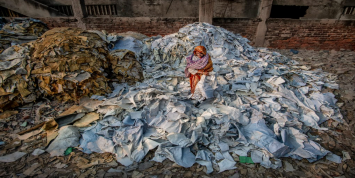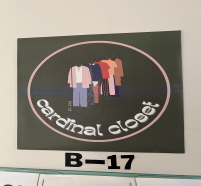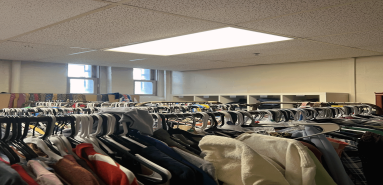By: Isabel Gonzalez-Alvarez
We all wish we were able to wear a different outfit everyday, with no outfit repetitions. However, upon attempting to keep up these wardrobes it becomes apparent that these costs add up rather quickly. Therefore we find ourselves putting our money towards fast fashion and cheaper options. Some examples you might know of are Shein, Temu, etc... But have you ever stopped to think where those clothes are coming from? How were they made? And how long will they truly last for you? These are only a few of the reasons as to why quality clothing strongly outweighs and surpasses the few benefits that quantity is able to provide.1

My Take on it
This year I have really focused on building my capsule wardrobe. What is a capsule wardrobe you might ask. A capsule wardrobe is a collection of clothes that are versatile and last for long periods of time. Building my capsule wardrobe means finding pieces that are well made. What does that mean? This means that even though it might be higher in price the thread count is higher and the overall structure of the piece is suited to perform for its function. Some more examples are the amount of stitches, lining, how durable it is going through the washing machines, etc... All of these factors being the qualities in which I strive to have in each piece of clothing in my wardrobe.
Who are the “IT” Boys and Girls
I began my journey on looking for quality clothing rather than the quantity of clothing during my senior year of college. I attended The Catholic University of America, located in Washington D.C. Living in the city was one of the best times of my life. I was surrounded by diversity, culture, and fast energy. This all fed into my fashion decisions on a day to day basis. Looking back into my first few years of college I was caught up in the latest fashion trends and wanting to have the newest, trendiest, piece of clothing. I regret not using that time and exploring the environment I was in to develop a more unique wardrobe. Using websites such as Shein to shop was very popular because we were broke college students. Looking back I notice that the incoming classes such as the freshman and sophmores set the tone of what fashion choices were going to be. That was because we were so impressionable and still learning about ourselves. Learning to express who we are as unique individuals through our fashion could have made a great change in my college experience. In addition, I later noticed that each group of friends dressed similarly, as if fashion was a way they were connected. That is why I think the younger generation of college students is the future. When looking at how quantity clothing can be made aware, I see that the younger generation of college students would be the population to focus on.
The Damage
Before looking into how you, as the younger generation, or the generation that can influence the younger ones, we need to look at what the purpose of this all is. I mentioned earlier that quality clothing is something that is well made with a good overall finish. A major benefit to having these quality pieces is that they will last you, the consumer, for much longer in comparison to the “quantity” counterparts. There are several ways in which poorly made clothing can cause damage. One of the largest affected areas is the ocean. With the combination of cheap and plastic based materials shed fibers, our oceans become contaminated with this pollution.
Waste is occurring in every single stage of the garment manufacturing process. Thus affecting and harming wildlife, degrading land, and polluting soil and water. The fast fashion industry is a large contributor to the climate crisis. It is responsible for as much as 10% of global carbon dioxide emissions. The animal-based textiles such as wool, which is used often in fast fashion clothing, are responsible for greenhouse gas emissions, water pollution, widespread habitat loss and other harms to wildlife. The scale of these fast fashion industries are concerningly large. A well known company such as Shein, has an estimated 1,000 new styles put up on the market daily. Although, it is speculated that those numbers are underestimated. According to the Shein website the average number of each garment manufactured ranges from 50-100. This results in a minimum of 50,000 new garments created on a daily basis.2

Clothing in Landfills
It is not unknown to the public that fast fashion is something to be concerned about. Although the world continues and is responsible for nearly 10% of global carbon emissions. What makes this subject more concerning is knowing that the average US consumer throws away 81.5lbs of clothes every year. In America alone, an estimated 11.3 million tons of textile waste which is equivalent to 85% of all textiles end up in landfills yearly. That’s equivalent to approximately 81.5 pounds per person, per year. Another fact to add is that the number of times a garment is worn has declined by around 36% in the last 15 years. The waste of clothing items has increased greatly over the past years as well. In this day in age many items are worn only seven to ten times before getting thrown away. It is estimated that half a million tons of the clothing waste reach the ocean each year. That is parallel to the plastic pollution of more than 50 billion bottles. These are all more reasons to protect not only our clothing by consuming more sustainable routines but clothing pieces as well.3
Be the Change You might be wondering how you can begin to make some changes in your wardrobe and how the younger college generation should begin to shift their preferences. One way is to look right on campus! In my university there was a thrift store on campus called cardinal closet. This is where students can drop off clothes that are still in good condition in order for someone to find it as their treasure. Being able to recycle clothes, even though it may be fast fashion, is a way to make that piece more sustainable and possibly a part of your capsule wardrobe. In addition to thrift stores, there are ways in which you can rent sustainable clothing that are higher in value to own but will be more feasible for your bank account at the moment. Promoting the shift of owning less clothing but purchasing higher quality clothing is something that the world itself will benefit from and so will your bank account.
You might be wondering how you can begin to make some changes in your wardrobe and how the younger college generation should begin to shift their preferences. One way is to look right on campus! In my university there was a thrift store on campus called cardinal closet. This is where students can drop off clothes that are still in good condition in order for someone to find it as their treasure. Being able to recycle clothes, even though it may be fast fashion, is a way to make that piece more sustainable and possibly a part of your capsule wardrobe. In addition to thrift stores, there are ways in which you can rent sustainable clothing that are higher in value to own but will be more feasible for your bank account at the moment. Promoting the shift of owning less clothing but purchasing higher quality clothing is something that the world itself will benefit from and so will your bank account.

Footnotes
1 ‘The Importance of Quality over Quantity’. FRANC. N.p., n.d. Web. 10 Mar. 2024.
2 ‘At What Cost? Unraveling the Harms of the Fast Fashion Industry’. N.p., n.d. Web. 10 Mar. 2024.
3 ‘At What Cost? Unraveling the Harms of the Fast Fashion Industry’. N.p., n.d. Web. 10 Mar. 2024.
